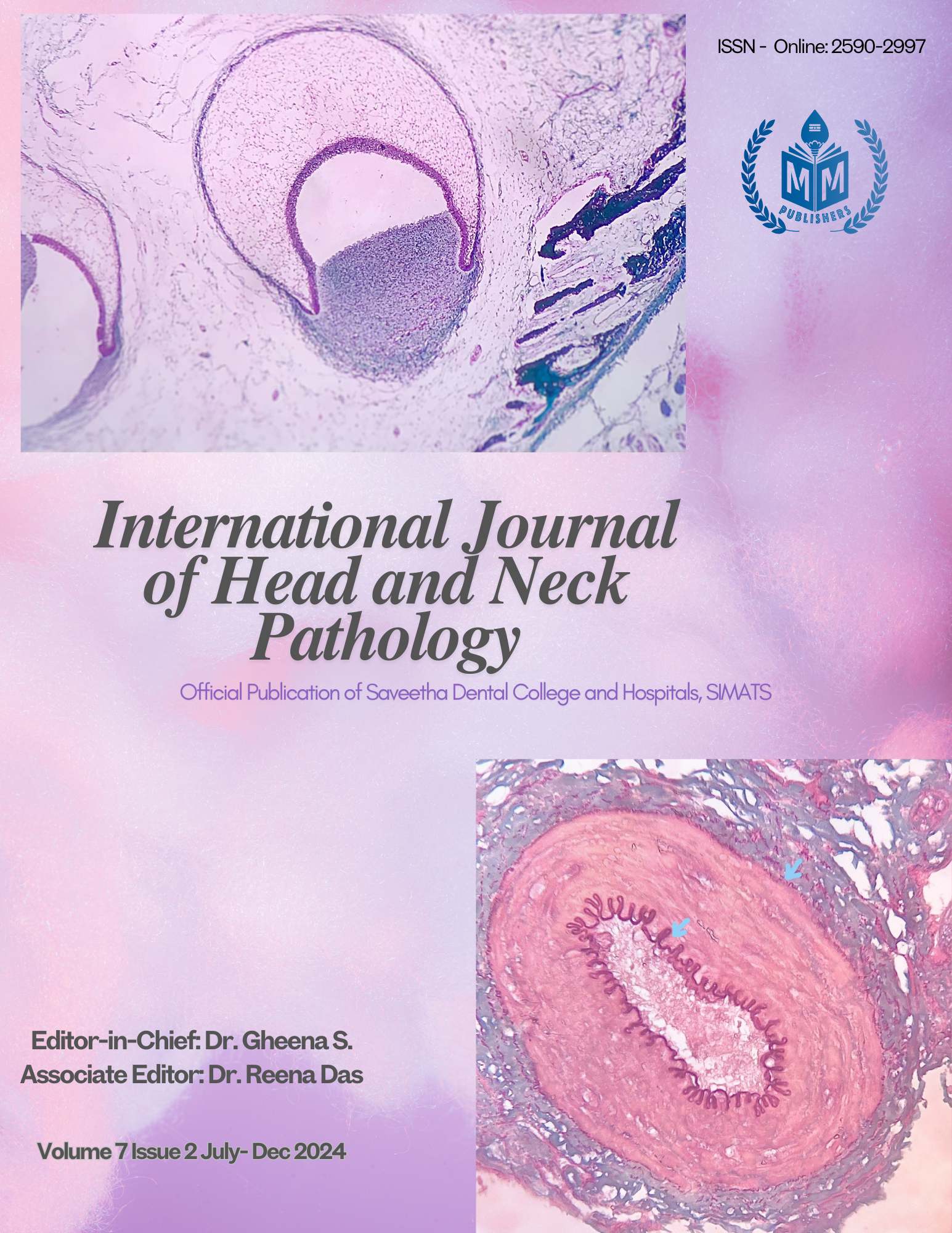Encapsulated Oncocytic Variant Of Papillary Thyroid Carcinoma With Extensive Infarction: A Diagnostic Dilemma Case Report
Main Article Content
Abstract
Oncocytic variant of Papillary Thyroid carcinoma (PTC) is a rare subtype of PTC. Diagnosis is based on the oncocytic tumor cells showing nuclear features of PTC in more than 75% of the tumor. We describe one such rare occurrence in a 45 year old male who was diagnosed as a hurtle cell neoplasm on Fine Needle Aspiration and underwent hemithyroidectomy. Gross specimen revealed near total infarction of tumor due to prior FNA. However careful and extensive sampling of the periphery of the tumor revealed oncocytic tumor cells with classic nuclear features of PTC showing positivity for CK7, CK19, CD56, TTF-1. There was no evidence of capsular or vascular invasion. Thus the case was diagnosed as encapsulated oncocytic variant of PTC. The pitfalls in diagnosis are discussed in detail.
Article Details

This work is licensed under a Creative Commons Attribution-NonCommercial 4.0 International License.
References
Gross M, Eliashar R, Ben-Yaakov, A. et al. Clinico- pathologic features and outcome of the oncocytic variant of papillary thyroid carcinoma. The Annals of Otology, Rhinology and Laryngology. 2009; 118:374-381.
Berho M, Suster S. The oncocytic variant of papillary carcinoma of the thyroid: a clinicopathologic study of 15 cases. Human Pathology. 1997; 28:47-53.
González-Cámpora R, Herrero-Zapatero A, Lerma E, Sanchez F, Galera H. Hürthle cell and mitochondrion-rich cell tumors. A clinicopathologic study. Cancer. 1986; 57:1154-63.
Herrera MF, Hay ID, Wu PS, Goellner JR, Ryan JJ, Ebersold JR et al. Hürthle cell (oxyphilic) papillary thyroid carcinoma: a variant with more aggressive biologic behavior. World. J. Surg. 1992; 16:669-674.
Wu HH, Clouse J, Ren R. Fine-needle aspiration cytology of Hürthle cell carcinoma of the thyroid. Diagn. Cytopathol. 2008; 36:149-54.
LiVolsi VA, Merino MJ. Worrisome histologic alterations following fine-needle aspiration of the thyroid (WHAFFT). Pathol. Annu. 1994; 29:99-120.
Bolat F, Kayaselcuk F, Nursal TZ, Reyhan M, Bal N, Yildirim S, et al. Histopathological changes in thyroid tissue after fine needle aspiration biopsy. Pathol Res Pract 2007 ;203:641-5.
Cheung CC, Ezzat S, Ramyar L, Freeman JL, Asa SL. Molecular basis off hurthle cell papillary thyroid carcinoma. J Clin Endocrinol Metab. 2000; 85:878-882.
Chiappetta G, Toti P, Cetta F, Giuliano A, Pentimalli F, Amendola I. The RET/PTC oncogene is frequently activated in oncocytic thyroid tumors (Hurthle cell adenomas and carcinomas), but not in oncocytic hyperplastic lesions. J. Clin. Endocrinol Metab. 2002;87:364-369.
Belchetz G, Cheung CC, Freeman J, Rosen IB, Witterick IJ, Asa SL. Hürthle cell tumors: using molecular techniques to define a novel classification system. Arch Otolaryngol Head Neck Surg. 2002; 128:237-40
Abouhashem NS, Talaat SM. Diagnostic utility of CK19 and CD56 in the differentiation of thyroid papillary carcinoma from its mimics. Pathol. Res. Pract. 2017; 213:509-517.
Carr AA, Yen TWF, Ortiz DI, Hunt BC, Fareau G, Massey BL. et al., Patients with Oncocytic Variant Papillary Thyroid Carcinoma Have a Similar Prognosis to Matched Classical Papillary Thyroid Carcinoma Controls. Thyroid. 2018 ;28:1462-1467.

